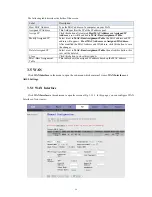
Fig 3.5.1-1
Label
Description
Current ATM VC Table
This table shows the PVCs already existed. It shows the Interface name,
Channel Mode, VPI/VCI, Encapsulation mode, local IP Address, Remote
IP address, etc. The maximum item of this table is eight.
VPI
(Virtual Path Identifier) The virtual path between two points in an ATM
network, and its valid value is from 0 to 255
VCI
The virtual channel between two points in an ATM network, ranging from
32 to 65535 (1 to 31 are reserved for known protocols)
Encapsulation
Choices are LLC and VC-Mux.
Channel Mode
There are five choices: 1483 Bridged, 1483 MER, PPPoE, PPPoA and
1483 Routed.
Admin Status
If select Disable, this PVC will be unusable.
Enable NAPT
Select it to enable the NAPT functions of the MODEM. If you are not to
enable NAPT and intend the user of the MODEM to access the Internet
normally, you must add a route on the uplink equipment; otherwise the
access to the Internet will fail. Normally, it is required to enable NAPT.
PPP Settings
Login Name
The correct user name that your ISP has provided to you.
Password
The correct password that your ISP has provided to you
Connection Type
The choices are
Continuous
,
Connect on Demand
and
Manual
.
Idle Time(min)
If select
Connect on Demand
, you need to input the idle timeout time.
Within the preset minutes, if the MODEM doesn’t detect the flow of the
user continuously, the MODEM will automatically disconnect the PPPOE
connection.
WAN IP Settings
Type The
choices
are
Fixed IP
and
Use DHCP
. If set
Fixed IP
, you should
enter the
Local IP Address
,
Remote IP Address
and
Subnet Mask
. If set
Use DHCP
, your MODEM will be a DHCP client, the WAN IP will be
assigned by the remote DHCP server.
Local IP Address
This is the IP of WAN interface which is provided by your ISP.
Remote IP Address
This is the gateway IP which is provided by your ISP.
Subnet Mask
This is the Subnet Mask of the
Local IP Address
.
Unnumbered
Select this checkbox to enable IP Unnumbered function.
Default Route
Add
After configuring the parameters of this page, click this button then a new
PVC will be added into
Current ATM VC Table
.
Modify
Select a PVC in the
Current ATM VC Table
, then modify the parameters
of this PVC. When you finish, click this button to apply the change of this
PVC.
Delete
Select a PVC in the
Current ATM VC Table
, then click this button to
delete this PVC.
Undo
Click this button to begin configuring this screen afresh.
ATM Setting
Click this button, the Fig 3.5.1-3 will appear. In this page, you can
configure ATM PVCs’QoS mode. The details, please see the following
pages.
Click this button, the following screens will appear. In these pages, you
can modify the PVCs’ parameters.
If the PVC uses PPPoE mode, click
, the Fig 3.5.1-2 will appear. In this page, you can configure this PPPoE
PVC’s parameters.
27
















































